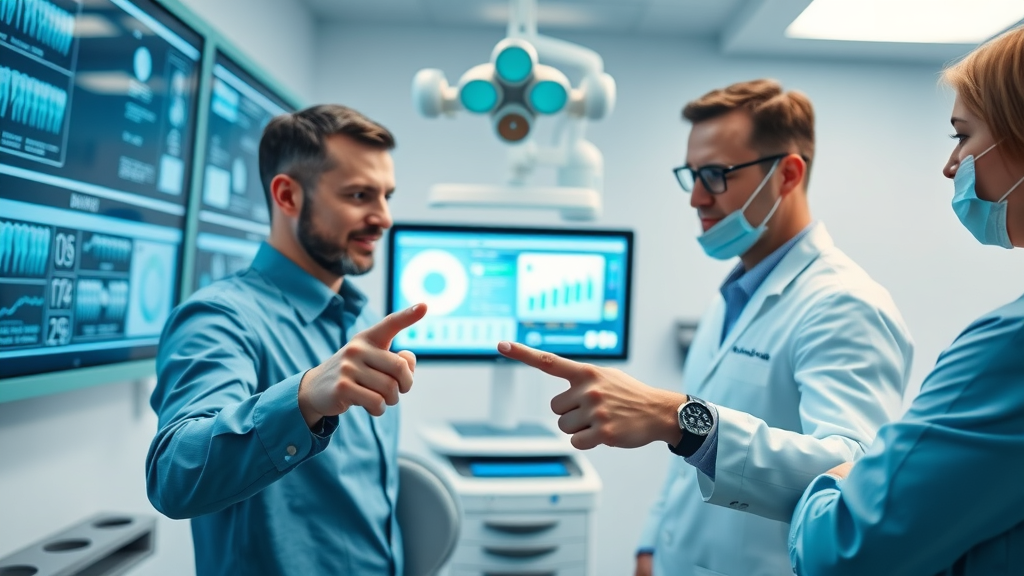Did you know ineffective dental office communication is the number one reason for workflow bottlenecks and patient dissatisfaction—contributing to as much as 35% of operational hiccups in dental practices? Unlocking clear communication doesn’t just remove stress and errors; it can radically transform your practice’s culture, patient loyalty, and the daily lives of your dental team . If you’re looking for actionable ways to streamline workflows and create positive outcomes for both staff and patients, this guide will reveal the secret strategies you need—starting from today.
Transforming Dental Office Communication: Surprising Facts That Change Everything
In today’s fast-paced world, dental office communication is more than just answering phone calls or passing notes. It is an intricate network of verbal, non-verbal, and digital exchanges that profoundly impact all aspects of a dental practice . Often overlooked, even minor missteps in communication can snowball into major inefficiencies, leading to lost appointments, misunderstandings on the treatment plan , and patient dissatisfaction. For instance, research shows that dental offices with streamlined communication systems see a 40% increase in patient retention and happier, more engaged staff. Practical evidence consistently highlights the relationship between high-functioning communication and smooth, stress-free workflows in the dental environment.
The most successful dental practices recognize the power of clear and consistent messaging—from the front desk to the operatories. By leveraging modern office communication systems, empowering staff with essential communication skills , and fostering a culture of transparency, dental offices of all sizes can experience enhanced patient satisfaction and more positive outcomes. Ultimately, transforming your dental office communication is the foundational step in building a thriving, modern practice.

The Startling Link Between Dental Office Communication and Patient Satisfaction
Strong dental office communication isn’t just good for your team—it directly drives patient satisfaction . Patients often associate the quality of their dental care with the clarity and kindness of communication they receive. When dental professionals and office staff communicate seamlessly, patients experience less anxiety, their treatment plans are more transparent, and scheduling errors are minimized. This level of patient care builds long-term trust and leads to better reviews, recommendations, and retention rates.
External studies highlight that dental offices known for clear, empathetic communication enjoy up to double the number of positive patient reviews online. Furthermore, patients consistently state in surveys that clear explanations of dental procedures and strong listening skills make a significant difference. These findings reinforce the idea that communication is not a luxury—but a cornerstone of successful, modern dental practices .
- Enhanced workflows
- Reduced stress
- Happier teams
Why Dental Office Communication is the Backbone of Every Successful Dental Practice
A successful dental practice is built upon a solid foundation of effective dental office communication . Every interaction—from patient reminders to clinical handoffs and insurance clarifications—requires clarity and consistency for the dental team to function efficiently. When communication breaks down, errors multiply, and both patient and staff satisfaction decline. The entire team feels the impact, from delayed dental care to scheduling challenges, making communication the backbone for both routine operations and exceptional patient experiences.
Integrating robust office communication systems unites your team, ensuring that every team member , from hygienists to the front desk , is on the same page. This unity drives productivity, accountability, and a shared sense of purpose, all of which reflect positively on your patients. Today's dental offices are moving beyond traditional communication methods—embracing instant messaging, real-time notifications, and cloud-based solutions that keep everyone informed and organized for consistently positive outcomes .
How Clear Dental Office Communication Optimizes Patient Communication
When dental office communication is clear, patients receive timely updates about appointments, financial responsibilities, and follow-up care. This clarity helps alleviate patient anxieties and enhances their understanding of the care process, strengthening overall patient communication . With standardized workflows for calls, texts, and emails, confusion is minimized, and patients consistently report higher trust levels in their dental team. Effective communication ensures patients never feel in the dark about their dental care, building trust and long-lasting relationships.
Additionally, transparent communication empowers patients to ask questions and actively participate in decision-making. Using digital reminders or educational brochures further supports patients in following their treatment plan, ultimately leading to improved dental health outcomes. This attention to detail in communication means fewer mistakes, more confident patients, and streamlined dental visits.
Office Communication Systems: Uniting the Dental Team
Modern office communication systems serve as a digital backbone for dental practices, uniting every team member in real time. Instant messaging apps, shared digital calendars, and integrated patient portals help the entire team stay informed. By removing guesswork from daily routines, these systems ensure no request is overlooked and that everyone—dentists, hygienists, assistants, and administrative staff—knows their responsibilities. This boost in unity leads to smoother patient handoffs and improved practice management .
Technological advancements have made it easier than ever before for dental teams to collaborate quickly and efficiently. Instant notifications reduce lengthy meeting times and minimize misunderstandings, helping staff respond faster to patient requests and scheduling changes. Ultimately, unified communication frees up valuable time, leading to both better patient outcomes and higher job satisfaction among staff.
"The art of communication is the language of leadership." – James Humes
Essential Communication Skills: Building Blocks of Dental Office Communication
Great dental office communication is built upon essential communication skills —from clear verbal messaging to subtle cues in body language and the ability to practice active listening . Cultivating these building blocks empowers every member of the dental team to connect with patients and colleagues alike, ensuring smoother workflows and fostering a collaborative, supportive environment.
Investing in communication skills development isn’t optional; it is a fundamental requirement for providing excellent patient care and achieving operational excellence. By fostering open communication channels throughout the office and emphasizing compassionate verbal and non-verbal interactions, dental practices can create an environment where positive outcomes thrive, and both patients and employees feel valued.
Verbal Communication: Speaking with Authority and Compassion in Dental Practice
Clear, compassionate, and concise verbal communication forms the heart of every patient interaction in a dental practice . Whether delivering complex clinical information or handling financial arrangements, it’s crucial for dental professionals to be articulate, approachable, and empathetic. By explaining procedures in simple terms and checking for understanding, providers eliminate confusion and reduce anxiety—making the patient communication process collaborative rather than intimidating.
The most effective dental professionals master the art of balancing authority and warmth. Using appropriate tone and language, maintaining comfortable eye contact , and demonstrating open body language can all help patients feel heard and respected. Regular staff training and scripting for common scenarios can further enhance the consistency and quality of verbal communication across your dental office , building lasting patient trust and improving overall satisfaction.

Body Language: Non-Verbal Communication in Dental Office Environments
Non-verbal cues like posture, facial expressions, and gestures play a critical role in dental office communication . Patients often draw conclusions about their care and comfort based solely on the body language of their dental team. A warm smile, open stance, and attentive nod can signal competence and compassion, lowering patient anxiety and making them feel truly seen as individuals, not just as cases.
Conversely, negative non-verbal signals—such as crossed arms, lack of eye contact , or distracted behaviors—can create barriers, leading to mistrust or reluctance to follow through with a treatment plan . Dental leaders should encourage team members to be mindful of their own facial expressions and posture and to use positive body language to communicate support and reassurance, both to colleagues and patients.
Active Listening: Empowering the Dental Team and Boosting Office Communication
A cornerstone of effective office communication is active listening . This involves giving patients and colleagues undivided attention, acknowledging their concerns, and responding thoughtfully. For dental professionals, mastering active listening means validating the patient’s feelings, clarifying their questions, and ensuring their needs are fully addressed.
Beyond patient interactions, active listening builds respect and teamwork within the dental office, nurturing greater collaboration and fewer misunderstandings among the office staff. Encouraging feedback, repeating critical information for confirmation, and summarizing next steps all signal attentive, active listening—leading to more accurate, happier, and more productive team dynamics.
Modern Dental Office Communication Systems: Tools for Enhanced Patient Communication
Today’s dental office communication systems integrate cutting-edge digital tools to streamline communication, automate workflows, and enhance patient communication outcomes. From cloud-based messaging platforms to patient portals and appointment reminder systems, digital innovation is transforming how dental offices operate. These tools don’t just foster teamwork; they also elevate patient care by ensuring timely notifications, digital consent forms, and seamless record-sharing.
Selecting the right office communication system is vital. The most effective systems are user-friendly, compatible with existing dental software, and flexible enough to adapt to each practice’s unique workflows. Embracing these modern technologies helps cut out inefficiencies and delivers on the promise of a smooth, connected dental experience for both staff and patients.

Choosing the Right Office Communication System for Dental Practices
With countless office communication systems on the market, finding the best fit for your dental practice requires a thorough evaluation of your current needs and future goals. Start by identifying pain points—such as slow response times, missed messages, or scheduling errors—and seek systems that specifically address those issues. Consider whether your practice needs secure instant messaging, integrated scheduling, and automated reminders for optimal workflow.
Peer reviews, software demos, and vendor support are crucial criteria when selecting a system that suits your dental office . It’s essential to involve the entire team in the evaluation process to ensure adoption and seamless integration. Remember, the best systems are those that empower your dental professionals to communicate effortlessly, regardless of their role.
Digital Communication Systems: Software and Tools for Dental Professionals
Leading software solutions for dental office communication now offer robust features such as instant messaging, document sharing, secure patient messaging, and real-time alerts. These tools enable rapid, precise exchanges among dental professionals , improving coordination and reducing errors. Patient management platforms can sync with digital imaging, e-prescriptions, and billing—creating a truly interconnected dental ecosystem.
Some top options preferred by dental associations include:
- Encrypted messaging systems for HIPAA-compliant communication
- Automated appointment confirmations and follow-ups
- Cloud-based dashboards for real-time information
- Integrated instant messaging for internal staff collaboration
| System Name | Key Features | Best For | Integration | Security |
|---|---|---|---|---|
| Solution A | Appointment reminders, instant messaging, document sharing | Mid-large dental practices | Practice management, EHR | HIPAA-compliant |
| Solution B | Patient portals, secure messaging, cloud access | Small to mid-size dental offices | Limited integration | Encrypted messaging |
| Solution C | Custom alerts, staff chat, auto-escalation of urgencies | Large multi-location practices | Enterprise-level systems | Advanced encryption |
Creating a Culture of Effective Dental Office Communication Within the Dental Team
Building a culture based on effective dental office communication doesn’t happen by accident—it’s a deliberate process that’s cultivated daily. Dental leaders must actively foster open dialogue, encourage transparent information sharing, and model exceptional communication skills . Whether through regular team huddles, digital platforms, or training sessions, creating a safe space for both staff and patient feedback helps identify blind spots and empower team members to contribute ideas for improvement.
When every member of the dental team feels heard and valued, resistance to change decreases, and collaboration flourishes. This proactive environment reduces miscommunication, helps prevent workflow interruptions, and accelerates the adoption of new office communication systems . Establishing clear protocols, setting expectations, and providing timely feedback are the keys to sustained success and growing your dental practice .
Strategies for Improving Office Communication Across Dental Practice Departments
To enhance coordination across different departments, dental practices can employ practical strategies such as structured handoff protocols, standardized checklists, and frequent team meetings. Integrating digital dashboards that display live updates can ensure that everyone, from hygienists to administrative staff, remains informed about the day's priorities and unexpected schedule changes.
Another effective approach is cross-training staff to understand colleagues' roles. This builds empathy, reduces silos, and fosters seamless support, especially during busy periods or staff absences. By encouraging every team member to communicate concerns proactively, dental practices can quickly identify bottlenecks and resolve them collaboratively.

Staff Training: Enhancing Communication Skills and Patient Communication
Regular training sessions focused on communication skills help office staff adapt to new tools, practice empathy, and master both verbal communication and body language . Workshops, role-playing, and feedback sessions allow team members to practice handling difficult conversations, giving constructive feedback, and delivering clear instructions to patients and one another.
Investing in ongoing training isn’t just about mastering software; it’s about fostering confident, active listening , and equipping team members to handle emotionally charged situations with composure. The ultimate goal is a team that is resilient, adaptable, and unified in their approach to exceptional patient communication and care.
- Start every day with a brief team huddle to review priorities
- Establish standardized handoff protocols between clinical and administrative teams
- Encourage open feedback with regular communication check-ins
- Utilize digital instant messaging for urgent updates
- Schedule monthly team training on communication skills
Overcoming Barriers in Dental Office Communication and Patient Communication
Every dental practice faces communication challenges, from generational differences to technological limitations and busy schedules. Recognizing and proactively addressing these obstacles ensures your dental office communication system remains robust and resilient, capable of supporting smooth workflows and outstanding patient care.
By identifying common obstacles, encouraging feedback, and leveraging proven solutions, dental professionals can mitigate misunderstandings and create an office culture that thrives on positivity and effective communication strategies.
Common Obstacles in Dental Office Communication Systems
Frequent barriers include outdated or incompatible software, unclear protocols, and lack of dedicated communication tools, causing critical information to be lost or misinterpreted. Rapid staff turnover, language barriers, and inconsistent use of new technologies can further complicate matters, leaving team members struggling to stay on the same page.
Another major challenge is ensuring consistent use of digital communication tools, such as instant messaging platforms, across all levels of the team. Without proper adoption and training, valuable systems risk becoming underutilized and failing to deliver their full benefits.

Proven Solutions for Addressing Communication Breakdowns with Dental Professionals
To combat communication breakdowns, practices should create clear protocols for both digital and in-person communication and provide regular training to all team members. Implementing checklists, assigning communication champions, and running routine system audits help maintain high standards of effective communication .
Encouraging open channels—where staff can voice concerns and offer solutions—empowers the team to address obstacles before they escalate. Using instant messaging and cross-functional teams helps bridge gaps quickly, ensuring everyone is informed and involved in daily operations and patient care.
Case Studies: Real-Life Examples of Dental Office Communication Success
Consider a mid-sized dental practice that implemented a cloud-based communication system to replace paper charts and manual scheduling. Within six months, the team reported a 30% reduction in missed appointments and a notable boost in employee morale. Patients praised the practice for its prompt follow-ups and transparent communication about treatment options.
Another example involves a large multi-location group practice that rolled out standardized handoff protocols and monthly communication skill-building workshops. The outcome was striking: patient satisfaction scores soared, staff turnover dropped, and providers reported fewer misunderstandings regarding treatment plans and billing.
"Good communication is just as stimulating as black coffee, and just as hard to sleep after." – Anne Morrow Lindbergh

How to Evaluate and Upgrade Your Dental Office Communication System
Continuous improvement is essential for sustaining a thriving dental office communication system . Regularly auditing workflows, evaluating feedback from both staff and patients, and benchmarking system performance will reveal blind spots and opportunities for enhancement. Upgrading your communication system is not a one-off project—it’s an ongoing commitment to excellence and adaptation as your practice grows.
Start with a structured audit, use clear assessment criteria, and involve stakeholders at every step. Team buy-in is just as important as technical upgrades—ensure everyone sees the value in the new system for both their own work and patient experiences.
Step-by-Step Guide for Dental Practices to Audit Their Office Communication
Assessing your current office communication system involves several key steps:
- Map every communication flow, from appointment booking to patient discharge.
- Interview staff to uncover pain points and recurring issues.
- Gather patient feedback on communication clarity and responsiveness.
- Evaluate the use and integration of digital tools.
- Document gaps in processes and missed opportunities.
- User-friendliness and staff adoption rates
- Integration with clinical and administrative systems
- Security and HIPAA compliance
- Scalability as the practice grows
- Patient feedback and staff engagement metrics
| Audit Criteria | Current Status | Needs Improvement? | Action Item |
|---|---|---|---|
| User Adoption | 75% | Yes | Schedule additional training |
| Integration with Systems | Partial | Yes | Upgrade software package |
| HIPAA Compliance | Compliant | No | Monitor annually |
| Patient Feedback | Positive | No | Continue surveys |
The Impact of Dental Office Communication on Patient Communication and Trust
Your dental office communication system doesn’t just affect workflows—it shapes the very core of your patient relationships. Clear, compassionate communication builds mutual trust and ensures patients feel valued. From the moment a patient schedules their first appointment to post-visit follow-ups, every touchpoint is an opportunity to reinforce your practice’s commitment to patient care and transparency.
Practices that prioritize patient communication by providing prompt responses, clear explanations, and proactive outreach see dramatic improvements in satisfaction scores, loyalty, and referrals. Effective office communication is the catalyst for thriving, growing dental relationships.
Building Long-Lasting Patient Relationships Through Office Communication
Patient loyalty isn’t accidental—it’s built through every interaction, no matter how small. By ensuring the dental team communicates with empathy, thoroughness, and a patient-first mindset, practices lay the foundation for relationships that last and flourish. Offering clear instructions, personalized reminders, and genuine concern turns occasional patients into lifelong advocates for your dental office.
This approach doesn’t just improve patient outcomes—it creates a ripple effect of positivity, energizing the dental team and linking everyone’s efforts toward the shared goal of outstanding dental care .
How Office Communication Systems Improve Patient Communication Outcomes
Modern office communication systems offer automated reminders, digital check-in, and secure messaging, making it easier for patients to access information, confirm appointments, and communicate concerns promptly. These tools minimize missed appointments, reduce confusion around billing, and provide an accessible channel for feedback, all of which drive higher trust and more positive patient experiences.
Dental practices leveraging robust communication systems also report lower no-show rates, improved compliance with treatment recommendations, and a stronger reputation for reliability. As technology continues to advance, expect even more innovative ways to connect with and support your patient community.

Future Trends in Dental Office Communication Systems
The future of dental office communication lies in smart, AI-powered tools, predictive analytics, and seamless integration across devices. Voice assistants, intelligent appointment scheduling, and virtual patient advocates are all on the horizon, promising transformative improvements in both office workflows and patient journeys. Imagining a dental practice where communication is instantaneous, intuitive, and personalized is no longer a fantasy—it’s fast becoming the new expectation.
To stay ahead of the curve, dental offices must prepare to adopt and adapt to these advances, ensuring staff training keeps pace with new technologies and that every innovation supports, rather than complicates, the human touch at the center of dental care.

What are the types of communication in dentistry?
Comprehensive Overview Answer: Types of Communication in Dentistry
Dentistry relies on several distinct forms of communication to ensure excellent care and efficient practice management. Verbal communication involves clear and compassionate spoken exchanges between the dental team, patients, and office staff. Non-verbal communication covers vital cues like body language, facial expression, and eye contact, all working together to reassure and support the patient.
Digital communication methods, such as instant messaging and patient portals, help disseminate information efficiently both within the dental team and to patients directly. Written communication remains a cornerstone, from treatment plans to informed consent forms and billing letters. Together, these methods keep operations running smoothly, support patient trust, and are fundamental to modern dental office communication.
What are the five types of written communication that are used in a dental office?
Detailed Answer: Written Communication in a Dental Office
Dental offices continually utilize multiple types of written communication to document, educate, and inform:
- Treatment plans – Outlining procedures and expectations for both patients and staff.
- Appointment reminders and recall letters – Keeping patients informed about upcoming visits.
- Informed consent forms – Ensuring patients understand the procedures and associated risks.
- Referral and recommendation letters – Facilitating specialist consultations and collaborative care.
- Billing statements and financial correspondence – Clarifying charges, insurance coverage, and payment plans.
What are the 5 steps of effective oral communication?
Step-by-Step Breakdown: Effective Oral Communication in Dental Office
The five steps of effective oral communication, essential for both patient communication and team collaboration, are:
- Preparation – Understanding the topic and audience before starting any discussion.
- Clear Delivery – Speaking in simple language and using an appropriate, warm tone.
- Active Listening – Focusing on what the other party is saying and seeking clarification where needed.
- Feedback – Encouraging questions and checking for understanding.
- Follow-up – Summarizing the conversation or providing a written recap for reference.
What are 5 basic communication skills?
Explaining Basic Communication Skills for Dental Professionals
For dental professionals , five vital communication skills form the basis for effective office and patient interactions:
- Verbal expression – The ability to convey ideas clearly, confidently, and with empathy.
- Non-verbal cues – Using body language to reinforce messages and provide comfort.
- Active listening – Demonstrating attentiveness to patient and staff needs.
- Written communication – Creating accurate, understandable documentation and correspondence.
- Feedback and clarification – Asking questions and encouraging dialogue to ensure mutual understanding.
Frequently Asked Questions about Dental Office Communication
-
What should a dental office communication policy include?
A comprehensive communication policy should outline standardized methods for internal and external communication, specify protocols for digital tools, and include confidentiality guidelines. Training expectations and escalation procedures for communication breakdowns must also be addressed. -
How can dental professionals improve verbal communication?
Regular practice, role-playing, and peer feedback sessions help refine verbal skills. Staying patient-focused, using clear language, and actively listening to patient concerns are essential steps that significantly enhance communication effectiveness. -
What tools are best for digital office communication systems?
Integrated platforms that offer instant messaging, cloud access, and secure document sharing are ideal. Solutions that synchronize with your dental software and prioritize HIPAA compliance ensure both efficiency and legal protection. -
How do office communication systems impact workflow efficiency?
Advanced office communication systems reduce time spent retrieving information, minimize errors, and streamline collaboration. By clarifying roles and automating routine messaging, practices enjoy smoother workflows and improved overall productivity. -
Best practices for integrating new dental office communication systems
Involve staff in the selection and implementation process, provide thorough training, and roll out systems gradually to ensure buy-in. Establish protocols, monitor user adoption, and collect feedback for ongoing system improvements.
Key Takeaways for Optimizing Dental Office Communication
- Effective dental office communication is vital for smooth workflows
- Integrating modern dental office communication systems boosts patient satisfaction
- Staff training and clear protocols strengthen communication skills
- Evaluating and upgrading office communication systems yields better outcomes
Take the Next Step: Enhance Your Dental Office Communication Today
- Assess your current dental office communication systems
- Invest in ongoing staff communication training
- Adopt new technology to streamline patient communication
- Contact dental communication specialists for a personalized evaluation
 Add Row
Add Row  Add
Add 




Write A Comment